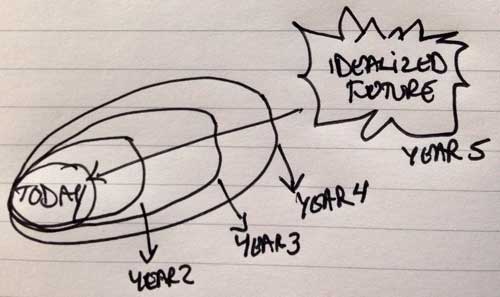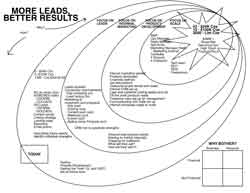Strategy and Planning are Different
Strategy and Planning are Different
This article originally appeared in Amalgamate: A Mix of Ideas for Your Business, Winter 2016
Consider the term Strategic Planning as an oxymoron. This was presented to me by Alan Weiss, PhD. in his book, Best Laid Plans. His point: strategy points you there and planning gets you there.
This fall I worked with five firms on strategy and I saw a striking similarity. If you split your strategic meeting from your planning meeting, a clearer action plan results.
Follow this model to get there.
In a strategic meeting, limit attendance to no more than three stakeholders. Regardless of how many partners you have, the strategic team needs to be small for this to work. Clarity of vision.
This meeting has one function: to develop a clear picture of where the firm will be in five years. Three years at the least. Sounds simple, but there’s a twist. Don’t consider today in this meeting. Free yourself from the burden of how things are and describe what you want.
I call it the idealized future.

The facilitator listens for anything that smacks of “today” and sidelines those comments with a “let’s ignore that for now and focus on how it looks, sounds, tastes and smells like when we get there.”
The reason for tabling the Present is that it limits growth. Consider sales projections that start with last year, then add a percentage for the coming year (scaled back “just in case”). That number guides the second year (then scaled back) which informs the third year (which is then scaled back). That isn’t strategy, that’s planning and it results in mediocre growth. Instead, get your leadership group to let go of the present and define the future.
Separately, schedule a planning meeting that brings all stakeholders together. The objective of this meeting will be to work backwards from the idealized vision to today.

This meeting has more players in the room and due to debate, is more chaotic in nature. But one thing is not up for debate: the idealized future. The strategic objective.
The planning group works back from the idealized future. The facilitator focuses the group saying things like “we’re not debating the goal. How do we make it happen?”
The facilitator starts at a point near the future and work back to today. “To get to year five, what do we need in place by year four. . .?”
Separate strategic planning meetings into two parts for clearer roles, responsibilities, and projections. You’ll end up with a easy to reference decision making tool like this:

Good stuff.

